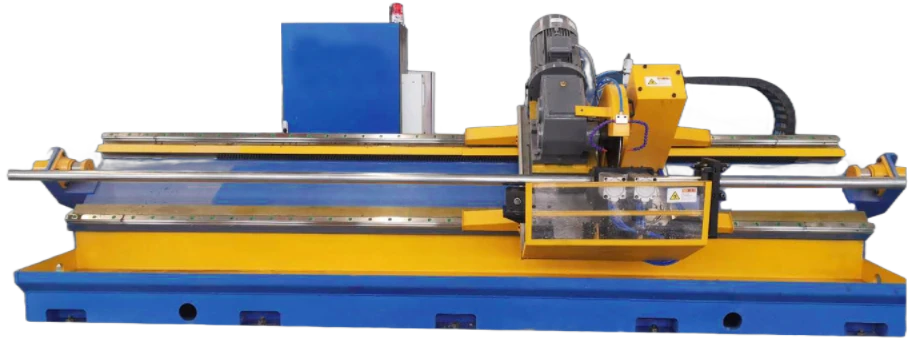reidius roll forming
The Significance of Radius Roll Forming in Modern Manufacturing
In the ever-evolving landscape of manufacturing, radius roll forming has emerged as a crucial technology that enhances productivity and precision. This process involves the continuous bending of metal strips into desired cross-sectional shapes, which are then formed into specific radius profiles. The name itself, “radius roll forming,” underscores the technique’s emphasis on creating curved transitions and smooth contours in various metal materials.
Understanding Radius Roll Forming
Radius roll forming is defined as a continuous process that shapes metal by passing it through a series of rollers. Each roller applies pressure to the material, gradually bending it into the desired curve or angle. Unlike traditional stamping or cutting methods, which can create jagged edges or geometric inaccuracies, radius roll forming allows for both precise geometries and smoother finishes, making it ideal for a wide range of applications.
This method is particularly beneficial for producing parts and components that require uniformity. By utilizing multiple sets of rollers, manufacturers can achieve consistent radius dimensions, which is critical for industries such as automotive, aerospace, and construction. The process can be adapted to work with various materials, including steel, aluminum, and other alloys, making it a versatile choice for many production environments.
Advantages of Radius Roll Forming
1. Efficiency One of the standout advantages of radius roll forming is its efficiency in production. Once the rollers are set up, the process can operate continuously, reducing downtime and allowing for high-volume output. This continuous flow not only shortens lead times but also minimizes labor costs associated with handling and processing materials.
2. Material Savings Radius roll forming is highly material-efficient. The process minimizes scrap waste since it utilizes metal sheets effectively and can incorporate advanced techniques like laser cutting to further reduce excess material. This advantage not only lowers material costs but also aligns with sustainable manufacturing practices, appealing to modern environmental standards.
reidius roll forming

3. Design Flexibility Radius roll forming offers significant flexibility in design. Engineers and designers can create intricate profiles and complex shapes that may be impossible or prohibitively expensive to achieve with other methods. This flexibility enables manufacturers to innovate and adapt quickly to changing market demands, enhancing their competitive edge.
4. Durability and Strength The continuous bending process enhances the material's structural integrity, resulting in components that are not only lightweight but also strong and durable. This characteristic is especially important for industries like construction and automotive, where resilience against wear and stress is paramount.
Applications of Radius Roll Forming
Radius roll forming finds application across various sectors. In the automotive industry, for instance, it is used to produce components like frames, brackets, and structural supports. These parts must meet stringent safety and performance standards, and the precision offered by radius roll forming ensures they are fit for purpose.
In the construction sector, the technique provides high-quality structural components such as beams and columns that require curved profiles for aesthetic and functional purposes. Architectural designs increasingly feature rounded and fluid lines, making radius roll forming an invaluable resource for modern construction projects.
Furthermore, radius roll forming is utilized in the production of other consumer goods, ranging from furniture frames to lighting fixtures. The versatility of this manufacturing process means that it can be tailored to suit different market needs, thus fostering innovation in design.
Conclusion
The advent of radius roll forming has substantially impacted the manufacturing landscape, providing a cost-effective, efficient, and precise method for producing complex metal shapes. As industries continue to evolve, the importance of innovative manufacturing techniques like radius roll forming cannot be overstated. With its myriad advantages, including reduced material waste and design flexibility, radius roll forming is likely to play a pivotal role in the future of manufacturing. The technology not only enhances production capabilities but also aligns with modern demands for sustainability and quality, making it a cornerstone of contemporary industrial practice. As more manufacturers embrace this method, we can anticipate exciting advancements and applications that will further revolutionize the manufacturing sector in the years to come.
-
High Frequency Straight Seam Welded Pipe Production Line-BzZhou Xinghua Machinery Equipment Manufacturing Co., LTD.|line pipe steel&welded gas pipeNewsJul.30,2025
-
High Frequency Straight Seam Welded Pipe Production Line-BzZhou Xinghua Machinery Equipment Manufacturing Co., LTD.|High Precision&Automated SolutionsNewsJul.30,2025
-
High Frequency Straight Seam Welded Pipe Production Line - BzZhou Xinghua Machinery Equipment Manufacturing Co., Ltd.NewsJul.30,2025
-
High Frequency Straight Seam Welded Pipe Production Line-BzZhou Xinghua Machinery Equipment Manufacturing Co., LTD.|Precision Welding, High EfficiencyNewsJul.30,2025
-
High Frequency Straight Seam Welded Pipe Production Line|BzZhou Xinghua|Precision Welding&EfficiencyNewsJul.30,2025
-
High Frequency Straight Seam Welded Pipe Production Line - BzZhou Xinghua|Precision Engineering&EfficiencyNewsJul.30,2025


